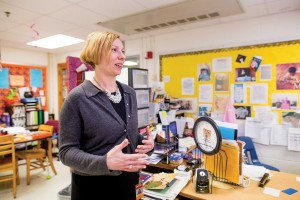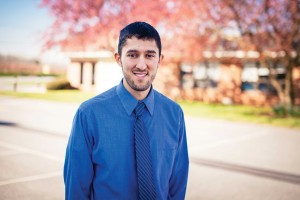
Jennifer Morris ’91 , principal at Shelburne Middle School in Staunton, Virginia, is among a cohort of local educators being trained in restorative justice practices. (Photo by Jon Styer)
Principal Jennifer Morris ’91 knew that restorative justice was catching on with the campus culture at Shelburne Middle School in Staunton, Virginia, when she heard the following story shortly after the first year of implementation:
In summer school, a student and his group were presented with a problem to solve. After a few unproductive minutes, during which the discussion threatened to dissolve into disharmony, the student said, “Okay, let’s circle up and figure
this out.”
The fact that a middle-schooler thought of the circle as a “go-to” tool for resolving everyday conflict says the school is teaching much more than academics: Students are also learning “how to get along with others, how to monitor oneself and be self-disciplined,” says Morris.
Morris, who is enrolled in the master’s in education program at EMU, has led Shelburne in implementing and practicing restorative justice principles (known as RJE) since embarking on an update of the school’s discipline plan two years ago – she is one of many administrators and teachers across the country exploring new ways of helping students reflect on their behavior and holding them accountable to each other and their school community.
A few hundred miles away, a similar ethos has been built on campuses of Lancaster (Pa.) Mennonite School (LMS), including the New Danville Elementary School campus where Eloy Rodriguez ’03, EMU board member, is principal. The concepts of restorative justice are not so new at LMS, with the process of cultural change beginning more than 15 years ago.

Eloy Rodriquez ’03, EMU board member, is principal at New Danville Elementary School in Pennsylvania. At his and other Lancaster Mennonite School campuses, restorative justice practices have been integrated into school culture for more than 15 years. (Photo by Joaquin Sosa)
Notably, both public education and Mennonite education systems have made strong statements in favor of restorative justice programs, known as RJE in school contexts.
Public school educators noted the Department of Education’s release of a RJE resource guide in 2014, partly in response to the disproportionately large number of minority and other marginalized students who under traditional punitive systems are suspended or expelled. These actions often lead to students of certain ages not returning to school, which raises the odds of potential unemployment or incarceration.
Mennonite educators, who have made restorative practices among foundational principles for at least two decades, reaffirmed their commitment at the biennial Mennonite Educators Conference in February 2016. That’s where LMS Superintendent J. Richard Thomas named, among other goals, “making restorative justice normative in Mennonite schools.”
Restorative justice is at the heart of Christ-centered education, says Rodriguez. Teach children “to be aware of how their actions may hurt others, to acknowledge the harm that’s been done and to develop a plan to make it right,” and those skills will help to create empathetic teenagers and young adults who are willing to practice reconciliation and forgiveness.
“This ‘third way’ kind of living in relationships is the foundation of a school culture that transforms lives, which enables students to become world changers through Christlike love, peacemaking and service,” Rodriguez said.
The momentum is gratifying to Professor Kathy Evans, who is lead faculty in EMU’s new MA in Restorative Justice in Education program (starting fall 2018). She’s become a resource to national media, which not only shares successes but has begun to question the efficacy of such programs in public schools, which are sometimes hastily constructed without buy-in from those affected most – teachers.
The implementation of an RJE program needs to be holistic, focused on transforming the school climate and culture, and also sustainable, she told The Atlantic. It isn’t a quick and easy process that can be implemented after a one-day training, she says. Building healthy relationships between all members of the learning community – students, teachers, administrators, caregivers – takes time.
At Shelburne, Morris is keeping sustainability at the forefront of the new model, which she’s building with the help of other Staunton educators who have sought additional training at EMU.
She urges other educators to seek training as well, whether the new MA in RJE offered by EMU or through coursework or trainings such as the Restorative Justice in Education Academy June 27-28 at EMU this summer.
RJE is “a different way of looking at the world, and it requires us to rethink practices that have been in effect for a long time,” Morris says. “This approach enables us to teach something that has a long-term impact on students’ lives.”
